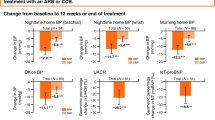Abstract
Nitrates decrease pulse pressure more than mean arterial pressure (MAP) and are advocated for the treatment of isolated systolic hypertension (ISH). Nitrates show drug tolerance during chronic treatment so an asymmetric dosing regimen may prevent loss of effect of nitrates. This study investigates the anti-hypertensive effect of isosorbide dinitrate (ISDN) given in a twice daily asymmetric dosing regimen in elderly patients with ISH.
After a 6-week placebo run-in period, patients entered the double-blind study. Ten patients received placebo and 11 patients ISDN 20 mg b.i.d. for 8 weeks. This dose could be doubled once. Office systolic and diastolic blood pressures (SBP/DBP) and ambulatory BP were measured. Pulse pressure was calculated as SBP–DBP.
Office pulse pressure was more reduced during ISDN (17.9%) than with placebo (5%; P < 0.05). sbp and map decreased compared to baseline, but the changes were not statistically significant between the two groups. dbp tended to increase with isdn compared to placebo. mean 24-h, mean daytime and mean night-time pulse pressure decreased after treatment with isdn (10.7%, 12.1%, 7.9%, respectively). pulse pressure tended to decrease more during the day than during the night with isdn. no changes could be demonstrated with placebo.
In conclusion, pulse pressure decreased with ISDN, resulting in a lower SBP without a decrease in DBP. The latter may preserve coronary perfusion in ISH. With the asymmetric dosing regimen the decrease in pulse pressure was not clear at night. Whether a decrease in nocturnal BP, in addition to the spontaneous decrease, is advisable in ISH remains a matter of debate.
This is a preview of subscription content, access via your institution
Access options
Subscribe to this journal
Receive 12 digital issues and online access to articles
$119.00 per year
only $9.92 per issue
Buy this article
- Purchase on Springer Link
- Instant access to full article PDF
Prices may be subject to local taxes which are calculated during checkout
Similar content being viewed by others
Author information
Authors and Affiliations
Rights and permissions
About this article
Cite this article
Starmans-Kool, M., Kleinjans, H., Lustermans, F. et al. Treatment of elderly patients with isolated systolic hypertension with isosorbide dinitrate in an asymmetric dosing schedule. J Hum Hypertens 12, 557–561 (1998). https://doi.org/10.1038/sj.jhh.1000664
Received:
Revised:
Accepted:
Published:
Issue Date:
DOI: https://doi.org/10.1038/sj.jhh.1000664
Keywords
This article is cited by
-
Sustained-release isosorbide mononitrate as adjuvant treatment in isolated systolic hypertension in the elderly
Journal of Human Hypertension (2022)
-
Effect of oral nitrates on pulse pressure and arterial elasticity in patients aged over 65 years with refractory isolated systolic hypertension: study protocol for a randomized controlled trial
Trials (2013)
-
Nitrates as adjunct hypertensive treatment
Current Hypertension Reports (2006)
-
Is there a preferred antihypertensive therapy for isolated systolic hypertension and reduced arterial compliance?
Current Hypertension Reports (2000)



